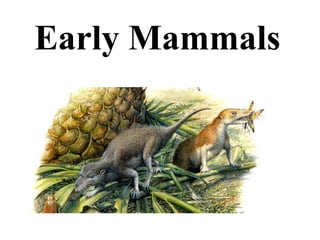
lectures number 3 mammalogy
- 2. Early lineages There are several early groups known as Mesozoic mammals. 1. Morganucodontids 2. Docodonts 3. Haramiyidans 4. Australosphenids 5. Triconodonts 6. Multituberculates 1. Morganucodontids: These are some of the earliest known mammals, from the latest Triassic and early Jurassic, and they’re best known from the genus Morganucodon. We actually have pretty good, complete fossils for this group, so we can make quite a few inferences.
- 3. Best know from the genus Morganucodon: Small – The skull length was around 3 cm and total length around 10 cm. Skull had large nasal cavity. Respiratory turbinates were present (Probably endotherms). Well-developed inner ear region. Very large eye sockets (Probably nocturnal). Primitive limb girdles.
- 4. Dentary was greatly expanded. Articular was small and still present. The angular was on mandible Cheek teeth had three cusps Alternate-side chewing. Insectivorous. They almost certainly had vibrissae (whiskers), based on pits and openings in the snout; so, they had hair.
- 5. 2. Docodonts • Oldest fossils are known from the Middle Jurassic, and the first known, Docodon, was discovered in the mid 1800’s in North America. • there were forms with aquatic adaptations, such as Castoricauda. • A new discovery is the genus Microdocodon, that has the hyoid apparatus preserved. • This is the skeletal support structure for the tongue, and it suggests that Microdocodon lapped milk and that these therefore lactated. Middle Jurassic, discovered in 1880. Hyoid apparatus Microdocodon Castoricauda
- 6. C.Haramiyidans: The haramiyidans were an old and persistent group; they first appeared ~220 MYA and persisted for ~80 MY. they had dentition that was adapted for herbivory. There were chisel-like incisors, a diastema (gap between incisors and cheek teeth). They retained the single ear ossicle; there was an articular in the mandible and quadrate in the cranium. many were arboreal. D. Australosphenids: Some Australian fossils discovered in the late '90s that exhibit a particular tooth type called tribosphenic molars It was originally thought that these were eutherians, based on these molars. However, the phylogenies indicate that these fossils are related to Monotremes, in the clade called Australosphenida. this molar type evolved at least twice. Early Cretaceous (~115 MYA) – Have eutherian-like tribosphenic molars. Bishops Ausktribo sphenos
- 7. E. Triconodonts • A complete Triconodont skeleton was discovered in China in 1999, the genus Jeholodens. • they have a very mammalian pectoral girdle. • Only a scapula and clavicle were present; the interclavicle and both pairs of coracoids are lost. • But the pelvic girdle is still ancestral; the ilium, ischium and pubis are separate, epipubic bones are present and not fused. • About 12 years ago, triconodont Repenomamus giganticus was discovered, • This is the largest mammal known from the Mesozoic, about a meter long, and probably was carnivorous. • In fact, in one specimen of the genus, a collection of bones from a small dinosaur were found where the stomach would have been, suggesting predation on dinosaurs
- 8. Teeth similar to Morganucodontids but cusps are linearized. Mammalian pectoral girdle. Pelvic girdle is still ancestral. Had a very sprawling posture. Great example of mosaic evolution. About a meter long, and probably was carnivorous. Derived pectoral girdle & ancestral pelvic girdle. Hu et al. (2005, Science, 433:139.). Repenomamus.
- 9. Multituberculates “Rodents of the Mesozoic” It is first known from the upper Jurassic and ranged from mouse-sized to marmot-sized. They extend through the Cretaceous into the Tertiary and existed with modern mammals. They are named for their unique dentition, There are chisel-like incisors or front teeth, with a large diastema (gap between front and cheek teeth). This arrangement is associated with herbivory. They had very complex, grinding molars; this is the character for which they’re named. There’s good evidence that at least some of the multituberculates were arboreal. The hypothesis is that, because of their specialized dentition, they were able to diversify into the many new herbivore niches that were available with the diversification of flowering plants. their pelvis suggest they may have been viviparous Diverse and persistent group Date from upper Jurassic, span Cretaceous-Tertiary, & coextisted with modern mammals. Mouse-sized to marmot-sized Named for their dentition. Chisel-like incisors. Large diastema. Complex, grinding molars (source of name)
- 10. Retained primitive pectoral and pelvic girdles. There’s good evidence that at lest some of the multituberculates were arboreal. Their diversification coincides with the early Cretaceous diversification of flowering plants (angiosperms). Other recently discovered fossils: 1. The genus Hadrocodium is very old mammaliaform fossil. It was discovered in 2001 and appears to be ca. 195 MY old. It is among the earliest known fossils to have three ear ossicles. 2. The genus Juramaia sinensis was discovered a few years ago This is the oldest known eutherian, ca. 160 MY old, and has a number of adaptations that suggest it was scansorial (adapted for climbing). The classical view is that all Mesozoic mammals were shrew-like, but a new understanding of their diversity has been emerging for a little over a decade (Luo et al. 2007): semiaquatic, carnivorous, fossorial, arboreal, and gliding forms have been discovered.